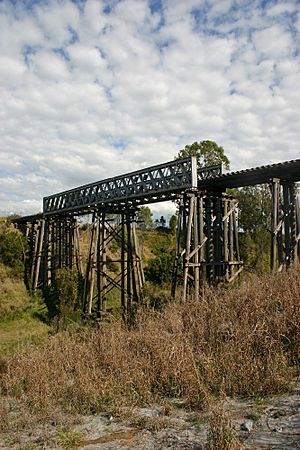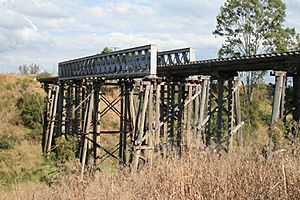Lockyer Creek Railway Bridge (Clarendon) facts for kids
Quick facts for kids Lockyer Creek Railway Bridge |
|
|---|---|

Lockyer Creek Railway Bridge (Clarendon), 2008
|
|
| Location | Brisbane Valley railway line, Clarendon, Somerset Region, Queensland, Australia |
| Design period | 1870s - 1890s (late 19th century) |
| Built | 1885 - 1886 |
| Architect | Henry Charles Stanley |
| Official name: Lockyer Creek Railway Bridge (Clarendon) | |
| Type | state heritage (built) |
| Designated | 21 October 1992 |
| Reference no. | 600495 |
| Significant period | 1880s, 1932, 1968 (fabric) 1886-1993 (historical use) |
| Significant components | pier/s (bridge) |
| Builders | H A Brigg |
| Lua error in Module:Location_map at line 420: attempt to index field 'wikibase' (a nil value). | |
The Lockyer Creek Railway Bridge is a special old bridge in Clarendon, Queensland, Australia. It was built a long time ago, between 1885 and 1886, to carry trains over Lockyer Creek on the Brisbane Valley railway line. A famous engineer named Henry Charles Stanley designed it. Today, it's listed on the Queensland Heritage Register because it's an important part of Queensland's history.
Contents
Building the Bridge
This railway bridge was an important part of the Brisbane Valley railway line. The second section of this line was built between the towns of Lowood and Esk.
Construction Begins
The company H. A. Brigg started building this part of the railway line on 2 December 1884. The Lockyer Creek Railway Bridge was a key structure on this route. The railway line between Lowood and Esk officially opened for trains on 9 August 1886.
Making the Bridge Stronger
Over the years, the railway line needed to be made stronger. This was so heavier and more powerful trains could use it.
- Upgrades in the 1930s: Between 1931 and 1933, the line was improved. This allowed bigger locomotives, like the C16 and C17 types, to travel on it. In 1932, a new wooden support, called a pier, was added in the middle of the main bridge section. This helped to make the bridge much stronger.
- Changes in the 1960s: In 1968, more changes were made. These changes prepared the bridge for even heavier diesel engines. Workers added strong metal channels along the sides of the bridge. They also placed new wooden beams, called transoms, on top. The wooden piers supporting the bridge were also given strong concrete bases.
End of Service
The railway line, and with it the Lockyer Creek Railway Bridge, stopped being used for trains in March 1993.
What the Bridge Looks Like
The Lockyer Creek Railway Bridge is a special type of bridge. It has a "half-through double x 2 lattice girder" design. This means it uses a strong criss-cross pattern of metal beams. It carries a single railway track straight across the creek.
Bridge Sections
The bridge is made up of several sections, or "spans," supported by wooden structures called trestles and piers.
- Timber Sections: Many parts of the bridge are made from strong timber. These sections use wooden beams and upright supports. Some supports have two uprights, while others have three, four, or five, sometimes braced for extra strength.
- Main Metal Span: The longest part of the bridge is about 30.5 meters (100 feet) long. This section uses the special metal lattice girders mentioned earlier. These metal beams were strengthened with channels and transoms. The wooden supports for this main section now have concrete bases, and an extra wooden pier was added in the middle to make it even stronger.
- Approaches: The parts of the bridge that lead up to the main section are also made of timber beams.
Why the Bridge is Important
The Lockyer Creek Railway Bridge at Clarendon was added to the Queensland Heritage Register on 21 October 1992. This means it's recognized as a very important historical site.
A Glimpse into History
This bridge helps us understand how Queensland's history unfolded. It's one of the oldest metal truss bridges still standing in Queensland. It was built around the same time as other important bridges like those at Miva and Wide Bay Creek in 1886. It also has the longest span of its kind built in Queensland between 1884 and 1932.
A Unique Design
The bridge shows a rare and special way of building. It's one of the few major bridges on the Brisbane Valley Branch line. Its design, with a 30.5-meter (100-foot) lattice girder span supported by timber piers, is similar to very old bridges from the 1860s. Most of those older bridges have been removed, making this one quite unique. Even though a timber pier was added later to make it stronger, you can still see how it was originally built.
Clever Engineering
The bridge also shows how clever engineers were during that time. Its design, with the half-through double x 2 lattice girder spans, was a great technical achievement. It was one of the oldest metal truss bridges of its kind and had the longest span of its type built in Queensland during that period.
Connection to Key People
The design of this bridge is linked to Henry Charles Stanley, who was the Chief Engineer at the time. His work was very important in Queensland's history.


